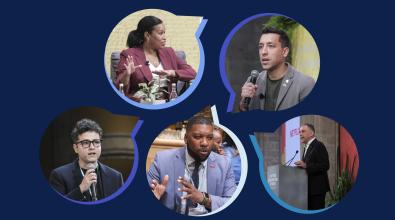 Read More
Read More
Using innovation to turn a budget crunch into opportunity
Listen to This Article
When he delivered his State of the City address in January, Mayor Todd Gloria was candid that San Diego had a problem: the local budget deficit had surged to $258 million. His city is far from alone. Many municipalities around the world are facing acute financial strain and are struggling to balance their budgets. But rather than settle for a less effective government, Mayor Gloria—who has participated in the Bloomberg Harvard City Leadership Initiative—highlighted his intent to use this moment as an opportunity to rethink how the city works.
“We adjust, we get creative, and we make the most of what we have,” Mayor Gloria said.
For Gloria himself, that means serving as both mayor and chief operating officer, which saves the city in salary costs and, the mayor believes, gives him a better view of how top priorities are being executed. And for his team, it means crowdsourcing solutions, bringing experimentation to core services, and tapping frontline staff to help train cost-efficient AI models. It’s an approach that aims to be deliberate about not just finding efficiencies or cutting where necessary, but also using this moment to rethink and improve how services are delivered. And it’s already offering lessons to local leaders everywhere about not just enduring budget stress, but making the most of it.
Pushing civil servants to think differently.
According to San Diego's Acting Chief Innovation Officer Alex Hempton, Mayor Gloria is urging his team to use this moment of financial strain as an opportunity to propose new ideas and work in new ways without sacrificing effectiveness.
“The message from the mayor is clear,” Hempton explains. “We need to rethink how we operate.”
For instance, the city is piloting an InnovateSD suggestion box, inviting staff to submit ideas that improve efficiency and customer service and generate revenue. Early proposals include opening spaces for AirBnB-style rental on city property and easing advertising restrictions to allow short-term campaigns that run the length of skyscrapers during large events like Comic Con, both aimed at better utilizing city assets and unlocking new income streams.
The next step is an upcoming Innovation Lab organized by the mayor for 500 city leaders, where participants will refine submitted ideas as well as build skills in journey mapping (to understand how people experience city services) and problem framing (to define the real challenge before jumping to solutions). It’s part of a broader effort to treat this moment as an opportunity to not just address budget concerns but also do things differently now and in the future.
“At this point, the message is: Give us all your ideas, and we’ll worry about how to implement them,” Hempton says.
Bringing experimentation to core services.
If crowdsourcing ideas is one way to better tap into the city’s human capital when its financial capital is stressed, another is to elevate innovators into leadership roles at key service agencies, where they can show staff what it means to take well-considered risks. And Kirby Brady, who served as chief innovation officer herself until she was tapped to lead the city agency providing sanitation services, is a prime example of that.
Her new approach starts with the basics, like improving the efficiency of how garbage trucks are routed to their stops. It also includes ensuring that the system the city is using to assess a new garbage fee passed by voters in 2022 is itself cost-efficient. For instance, rather than establishing a standalone payment mechanism, the city offers a simple portal that helps residents pick their level of service, and then seamlessly includes the fee on their property tax bill.
More broadly, Brady is working to change the agency's mindset by introducing a willingness to take incremental risks where there might have previously been an aversion to them. For instance, she’s “catching some heat,” as she described it, for installing tracking tools called readers on new compost bins that can be used to gauge performance and can also help the city identify when residents try to get their trash picked up twice in one day. The technology itself isn’t novel, but Brady argues that it’s a critical step toward customer accountability, and that just as she’s pushing drivers to change how they work, it’s important for residents to do their part, too.
“There's no better time to rethink how we're providing services, to make sure that we are providing the most value,” she argues.
Exploring new, cost-efficient AI use cases.
Frontline workers who repair infrastructure rarely have a say in how local governments design their AI systems. But that’s exactly what’s happening in San Diego, in yet another example of the city not just looking for blanket spending cuts but doing things differently to improve effectiveness.
Like many cities, San Diego addresses potholes and other pavement issues by either responding to resident complaints or, when the budget allows, paying hundreds of thousands of dollars for trucks outfitted with sensors to traverse every street to identify them. But by working alongside academic partners and innovation staff, the city’s transportation agency has developed an AI model geared at identifying potholes before residents complain about them for a fraction of the cost.
The model analyzes Google Street View images for potential potholes and, in turn, points repair crews toward streets that likely need service. To be effective, the model needs to be trained on what a pothole looks like, including the nuances of how local repair crews determine whether a pothole can be fixed quickly. That’s where transportation staff come in: teams visit potential pothole locations in the field and analyze photographs to help improve the model’s accuracy. “That's putting our field staff at the forefront of AI,” says Bethany Bezak, the city’s transportation director.
The city fixed its first pothole using this method just a couple of weeks ago, and plans to expand the effort from here. After all, the mayor was clear: tough financial times amount to a call to do things even more efficiently and effectively.
Ultimately, Bezak says, residents still expect the best—and it’s on local leaders to find new ways to give it to them. “We just have to think more creatively,” she says.

